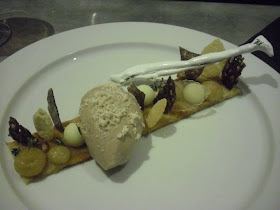It seems quite apt that Kødbyens Fiskebar is located in Copenhagen, where Hans Christian Andersen spent most of his life. That's because I'm not sure whether it represents the future of food as styled by Nordic culinary gods, or whether it's the Emperor's New Clothes.
The menu, majoring in fish and seafood, changes daily, and is presented on a clipboard. So far, so trendy. I kicked off with a starter of raw razor clams on maltbread crisp with fennel, dill and blobs of tarragon cream. The raw clams were pretty tasteless and insufficiently enlivened by the accoutrements. A bit of a let-down, all told.
For my main, I went with hake pan-fried in seaweed butter served with cabbage, Jerusalem artichoke cream, spring onion, croutons (dyed with squid ink) and mussel broth with tapioca. This was served with a bowl of creamed pearl barley with lovage, St John's wort and rye breadcrumbs.
There were so many components to this dish (I think I may have missed some out) that I was frightened my food would go cold before the waitress finished explaining what I was going to eat. The thing is I would've been quite happy with just the perfectly cooked hake in seaweed butter with a few greens on the side.
I could just about cope with the food on my plate, but what tipped it over the edge for me was the bowl of pearl barley on the side. Yes, it was tasty with interesting undertones of curry, and I appreciated the contrast in texture between the crunchy rye breadcrumbs and soft pearl barley. But what was the point? It was as if three separate courses from a tasting menu all turned up at the same time. There was just too much going on, and the clash of so many different tastes and textures ultimately detracted from a beautiful bit of fish.
The food didn't get any simpler with a dessert of Mutzo apples, almond, thyme and acorn ice cream. This was a posh apple tart, and in fairness, it was the highlight of the evening. In particular I thought the thyme meringue stick was genius and I enjoyed the contrast between the mini-balls of fresh apple and blobs of cooked apple.
Nevertheless, this dish did have its flaws; for instance, the acorn ice cream didn't really taste of anything (vanilla would actually have been a better option). And then there was the limp pastry that was strangely at odds with the otherwise technical excellence on show.
There was a lot to admire about my dinner, but not a lot to love about it. Yes, the cooking was, by and large, very skillful. Yet it was all a bit fussy with too many superfluous flourishes. Sometimes, less is more, and it's hoped that this message gets through to the Emperor in the kitchen. Otherwise, he may indeed end up stark-bollock naked.
The food aside, I liked the dining room, thought the service was informative and attentive, and it was good that you could eat at the bar (always a plus for solo business diners).
While I'm not sure if this restaurant is really for me, I am a big fan of the Kødbyen area (Copenhagen's answer to New York's Meatpacking District) in which it's located. There's a wide selection of bars and eateries there including the excellent Paté Paté.
Kødbyens Fiskebar, Flæsketorvet 100, DK-1711 København V
(Tel: +45-3215-5656)





I do wonder on where food is going these days. It seems if any is willing to forage for their ingredients and then dress the plate, so it resembles the scene from where your ingredients were found then they are the bees knees. As you said sometimes a simple dish is so much better. But Denmark is the new Spain.
ReplyDeleteLike Mzungu has alluded it's like molecular gastronomy all over again. How long before eedible sand is appearing on pub/bistro menus across the world..? It sounds like they have lost site of the main thing about eating out here while chasing a trend. This is alway sad when the cooking is obscured by attempts to conform to a style.
ReplyDeleteMzungu/Gworm - absolutely. I sometimes wonder about countries like Denmark and the UK, in that they try a bit too hard to lay down their foodie credentials, as they aren't historically perceived as foodie nations in the same way France and Italy (among others) are.
ReplyDelete